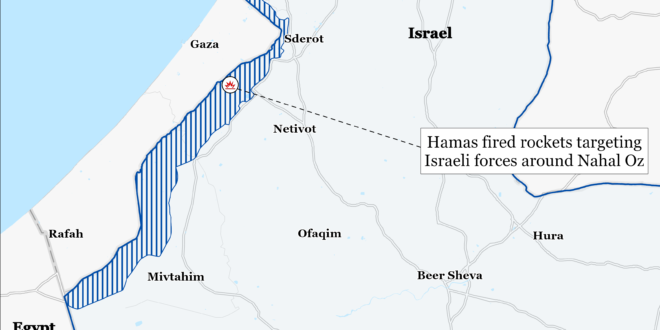Recent Iranian polls show that moderate Masoud Pezeshkian is leading over ultraconservative hardliner Saeed Jalili in the Iranian presidential race.[i] The runoff election will occur on July 5. The Iranian Students Polling Agency (ISPA) published a poll on July 4 showing that Pezeshkian has a 5.6 percent lead over Jalili.[ii] ISPA notably predicted accurately that Pezeshkian and Jalili would win the highest and second highest number of votes, respectively, in the first round of voting on June 28.[iii] ISPA also correctly predicted that pragmatic hardliner Mohammad Bagher Ghalibaf would receive significantly less votes than Pezeshkian and Jalili.[iv] The July 4 ISPA poll is consistent with CTP-ISW’s observation on July 1 that Pezeshkian appears to be gaining momentum ahead of the July 5 runoff election.[v]
Supreme Leader Ali Khamenei must decide whether he will permit Pezeshkian to win the election if Pezeshkian wins the most votes. Khamenei recently expressed foreign and nuclear policy views on June 25 that closely align with Jalili’s views, suggesting that Khamenei endorses Jalili.[vi] Khamenei furthermore indirectly criticized Pezeshkian’s campaign policies on the same date.[vii] Khamenei’s opposition to some of Pezeshkian’s policies could lead him to directly intervene in the upcoming election and install Jalili as president.
Israel and Hamas have resumed negotiations over a ceasefire in the Gaza Strip. Qatar sent Hamas on June 25 a revised ceasefire proposal that was based on an earlier US-backed proposal.[viii] The new proposal includes several unspecified amendments to the original text.[ix] Hamas has reviewed the new proposal and sent its response to Israel. Israeli leaders plan to discuss the Hamas response and send a delegation for further discussions.[x] Israeli Prime Minister Benjamin Netanyahu held a phone call with US President Joe Biden on July 4 to discuss the new proposal.[xi]
Hamas appears to have changed part of its maximalist negotiating position in its response to the new proposal. An anonymous Israeli official said that Hamas is no longer demanding the full withdrawal of Israeli forces during the first phase of the proposed ceasefire.[xii] This phase includes a six-week ceasefire and the release of some Hamas-held hostages. The phasing of the original US-backed proposal has been a point of disagreement between Israel and Hamas.[xiii]
Significant obstacles remain to securing a ceasefire agreement, however. Lebanese media reported that some of the changes in the new proposal do not “affect the essential issues” but are meant to preserve negotiations.[xiv] An Israeli official similarly told Axios that ”serious challenges” remain and that it could take several weeks to reach a deal.[xv]
Iran and the Axis of Resistance are conducting an information operation meant to prevent Israel from launching a major military offensive into Lebanon. An anonymous commander from the Islamic Resistance in Iraq told Western media that there would be an “escalation for escalation” if the IDF goes into Lebanon..[xvi] The Islamic Resistance in Iraq is a coalition of Iranian-backed Iraqi militias. The commander also told Western media that the coalition has sent military advisers and experts to Lebanon to help Lebanese Hezbollah prepare for a greater conflict against the IDF. These remarks come after two unspecified Iraqi officials told Associated Press that some advisers are already in Lebanon to support Hezbollah.[xvii] Iranian-backed Iraqi and Lebanese officials separately told the Associated Press that thousands of Iranian-backed fighters from across the Middle East would join the war between Israel and Hezbollah.[xviii] That the Axis of Resistance is speaking to Western media reflects its intent to message to Western audiences.
Key Takeaways:
- Iran: Recent Iranian polls show that moderate Masoud Pezeshkian is leading over ultraconservative Saeed Jalili in the Iranian presidential race.
- Gaza Strip: Israel and Hamas have resumed negotiations over a ceasefire in the Gaza Strip. Significant obstacles remain to securing a ceasefire agreement.
- Lebanon: Iran and the Axis of Resistance are conducting an information operation meant to prevent Israel from launching a major military offensive into Lebanon.
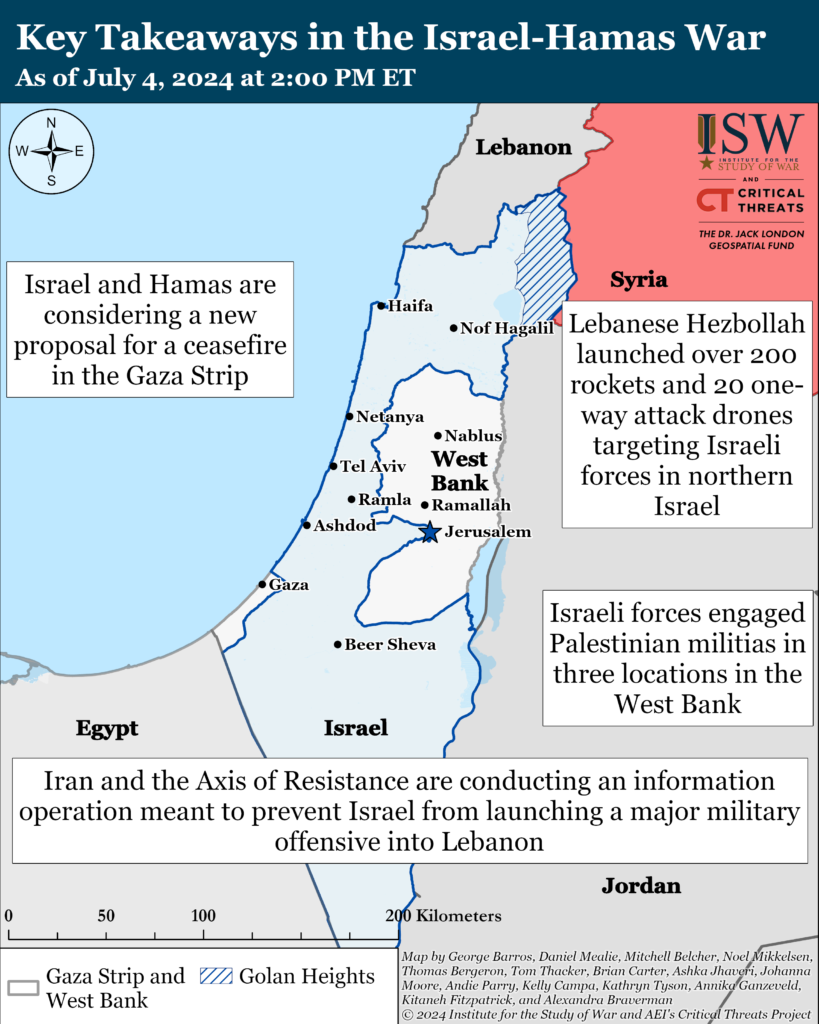
Gaza Strip
Axis of Resistance objectives:
Erode the will of the Israeli political establishment and public to sustain clearing operations in the Gaza Strip
Reestablish Hamas as the governing authority in the Gaza Strip
The IDF Southern Command directed an airstrike targeting Palestinian fighters in two UNRWA schools in Gaza City on July 4.[xix] An IDF Air Force helicopter and fighter jets struck Cairo School in al Rimal and Musa bin Nusair School in al Daraj.[xx] The IDF said that Hamas used the schools to plan and direct attacks targeting Israeli forces in the Gaza Strip.[xxi] Palestinian residents reported multiple casualties from the strike targeting Musa bin Nusair School.[xxii] The Gazan General Directorate of Civil Defense said that the Israeli strike targeting Cairo School did not cause casualties.[xxiii]
The IDF 98th Division continued operations to degrade a partially reconstituted Hamas battalion in Shujaiya, Gaza City, on July 4. The IDF Paratrooper Brigade killed seven Palestinian fighters in close range combat.[xxiv] The IDF 7th Brigade separately destroyed a Palestinian fighter cell during a close-range engagement.[xxv] Israeli forces destroyed several tunnel routes in Shujaiya.[xxvi] Three Palestinian militias mortared Israeli forces.[xxvii] Hamas and Palestinian Islamic Jihad (PIJ) continued to target Israeli forces with explosively formed penetrators.[xxviii] The use of sophisticated weapons and tactics is consistent with CTP-ISW’s previous reporting that Hamas’ Shujaiya Battalion has at least partially reconstituted since the IDF last operated in the area in April 2024.[xxix]
The IDF 99th Division continued operations along the Netzarim Corridor, south of Gaza City, on July 4. The 99th Division directed airstrikes to destroy militia infrastructure and kill Palestinian fighters.[xxx] The al Aqsa Martyrs’ Brigades fired mortars and rockets targeting Israeli forces along the Netzarim Corridor.[xxxi]
The IDF 162nd Division continued clearing operations in Rafah on July 4. The IDF Nahal Brigade directed a drone strike targeting several Palestinian fighters that threatened Israel forces in Rafah.[xxxii] Hamas detonated a tunnel entrance targeting an IDF unit in Tel al Sultan, west of Rafah.[xxxiii] The National Resistance Brigades fired a rocket propelled grenade targeting an Israeli armored personnel carrier in central Rafah.[xxxiv]
The IDF Air Force struck over 50 other militia targets throughout the Gaza Strip on July 4.[xxxv]
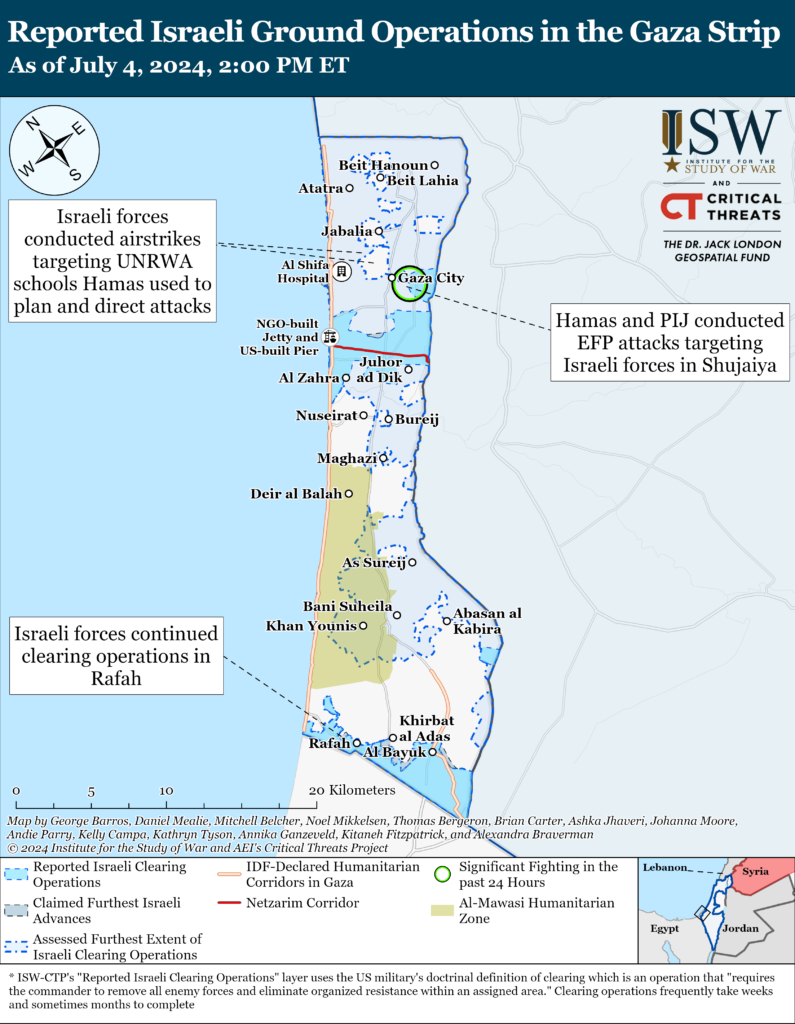
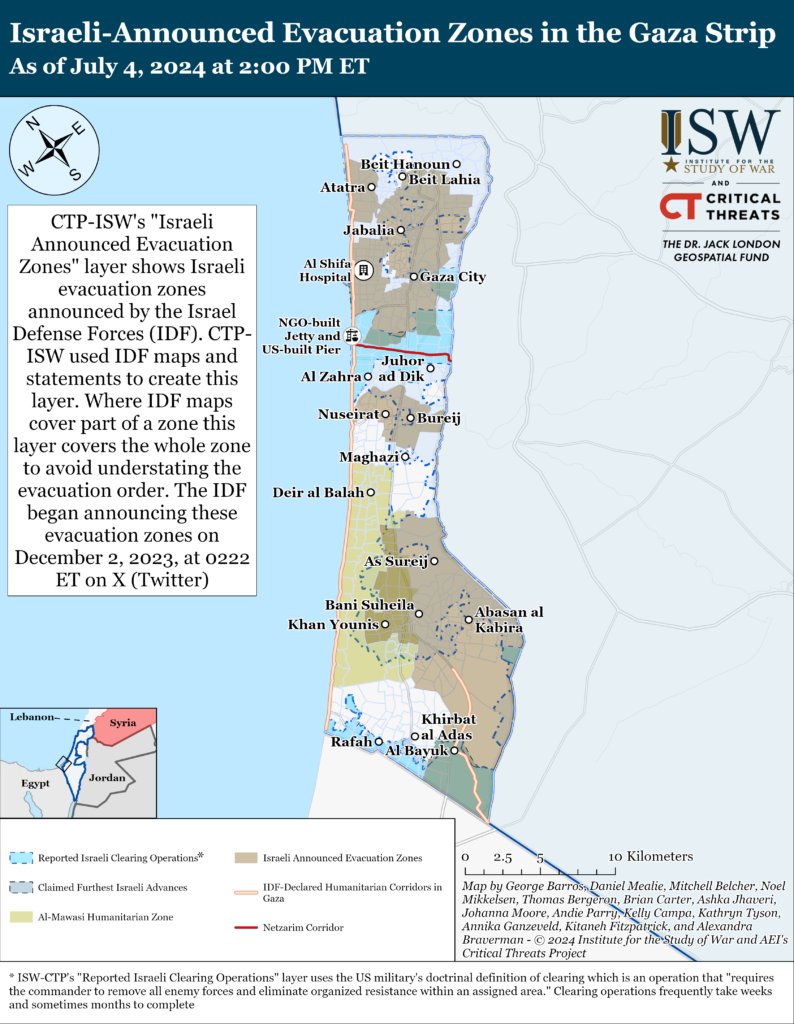
Hamas fighters launched a barrage of rockets targeting an IDF site in southern Israel on July 4.[xxxvi] Israeli Army Radio correspondents reported Israeli forces intercepted a rocket around Nahal Oz.[xxxvii]
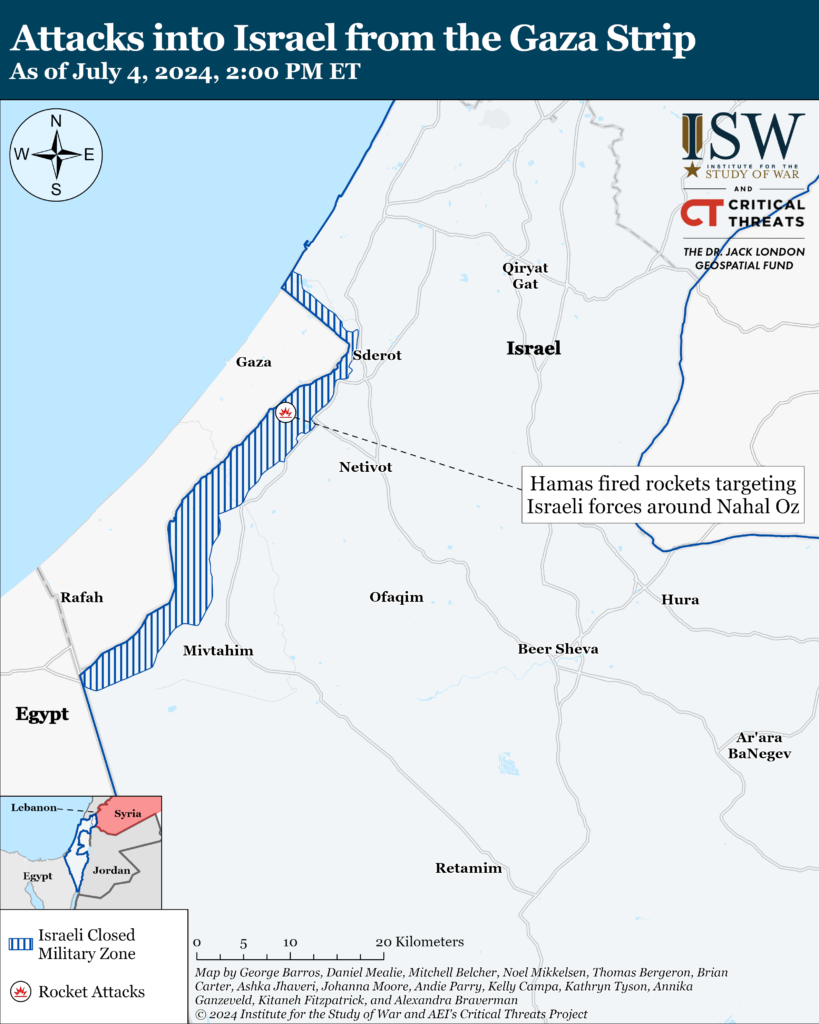
West Bank
Axis of Resistance objectives:
Establish the West Bank as a viable front against Israel
Israeli forces engaged Palestinian fighters in at least three locations since CTP-ISW’s last data cut-off on July 3.[xxxviii] Israeli forces detained three wanted individuals for ”inciting terrorism” during overnight raids. Israeli forces also seized printing materials for militia propaganda in Tulkarm on July 3.[xxxix] Palestinian media separately reported that Israeli forces conducted raids in at least nine locations since CTP-ISW’s last data cut-off on July 3.[xl]
The al Aqsa Martyrs’ Brigades released additional details of the slain Jenin Battalion Commander Nidal al Amer.[xli] Al Amer was responsible for several shooting attacks targeting Israeli checkpoints and developed ”resistance networks“ in Jenin. The readout claimed that al Amer played an “important role” in an al Aqsa Martyrs’ Brigades operation on June 27 that detonated improvised explosive devices (IED) targeting two military vehicles before ambushing Israeli forces in Jenin that claimed multiple IDF casualties.[xlii] An Israeli military correspondent described the June 27 IED explosion as particularly significant given that the militias buried the IEDs 1.5 meters underground, making them difficult for Israeli forces to detect.[xliii] Israeli forces killed al Amer in an “undercover operation” in Jenin refugee camp on July 3.[xliv]
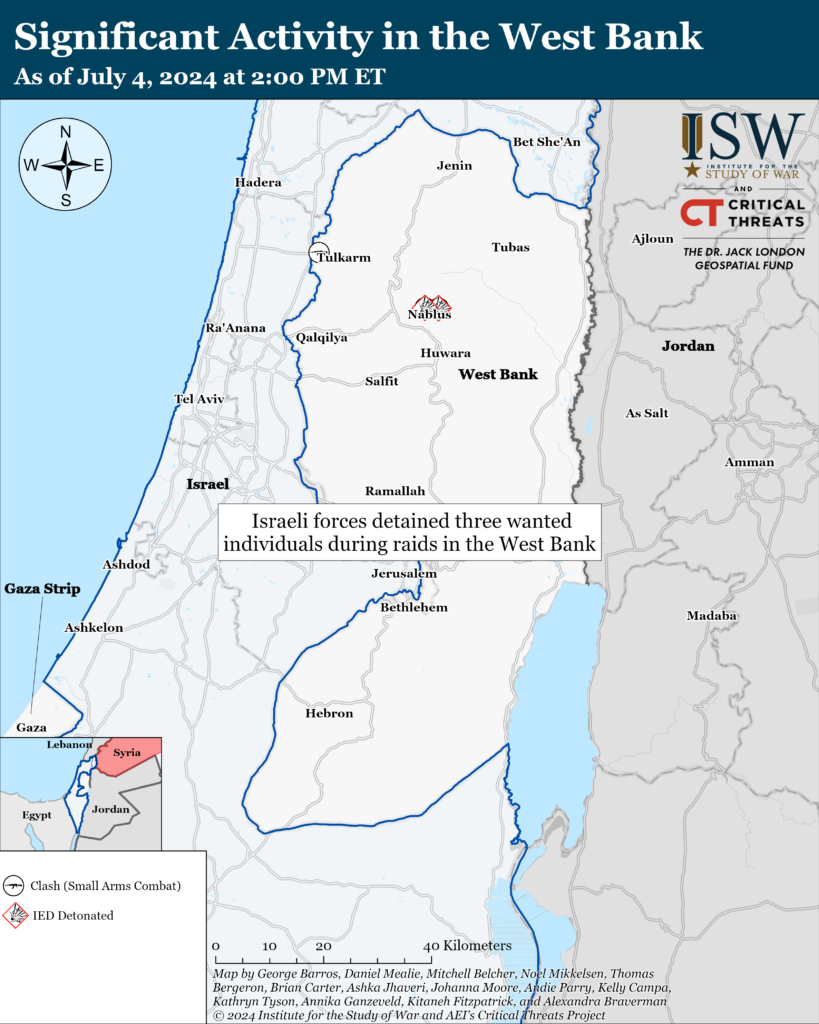
This map is not an exhaustive depiction of clashes and demonstrations in the West Bank.
Southern Lebanon and Golan Heights
Axis of Resistance objectives:
Deter Israel from conducting a ground operation into Lebanon
Prepare for an expanded and protracted conflict with Israel in the near term
Expel the United States from Syria
Lebanese Hezbollah conducted a large-scale drone and rocket attack into northern Israel on July 4.[xlv]Hezbollah launched over 200 rockets and 20 one-way attack drones targeting IDF sites in northern Israel and the Golan Heights.[xlvi] Hezbollah said that it targeted the 10 IDF sites in response to an IDF airstrike that killed a high level Hezbollah commander on July 3.[xlvii] Hezbollah’s response is largely consistent with its previous retaliatory attacks for IDF strikes on top commanders.[xlviii] Israeli strikes have killed two other senior Hezbollah commanders in 2024.[xlix] The Hezbollah 200-rocket barrage killed one IDF reservist in northern Israel.[l] Hezbollah targeted seven additional sites, including some with the 300 to 500-kilogram Burkan rockets.[li]
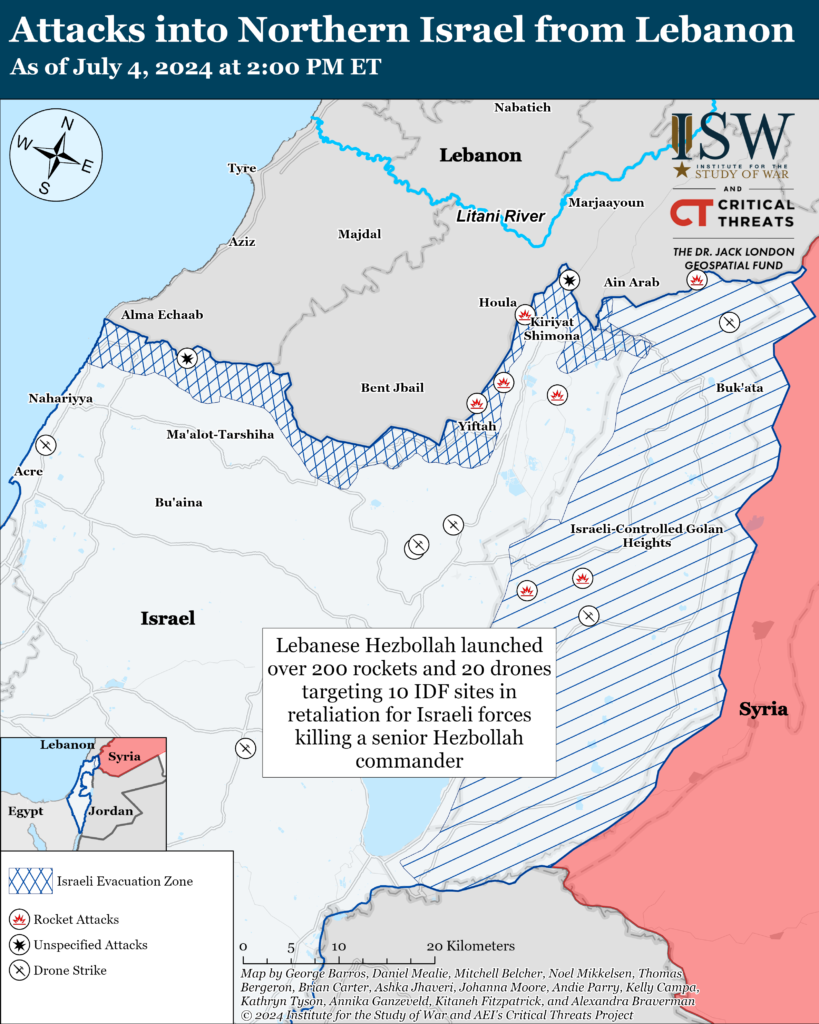
Recorded reports of attacks; CTP-ISW cannot independently verify impact.
Iran and Axis of Resistance
Interim Iranian President Mohammad Mokhber attended the 24th Shanghai Cooperation Organization (SCO) summit in Astana, Kazakhstan, on July 4.[lii] Mokhber met with Russian President Vladimir Putin to discuss strengthening Iranian trade with the Eurasian Economic Union (EEU). Putin expressed support for Iran becoming an observer member of the EEU on the sidelines of the summit.[liii] Mokhber boasted that the Iranian-Russian strategic partnership has challenged the US-led global order. Mokhber separately met with Chinese President Xi Jinping.[liv] Mokhber praised BRICS during his speech at the summit.[lv] Mokhber also expressed his hope for increased commercial interaction and infrastructure cooperation between Iran and the SCO.[lvi]
US Central Command (CENTCOM) struck two radar sites in Houthi-controlled areas of Yemen on July 3.[lvii] CENTCOM also engaged two unmanned surface vessels in the Red Sea on July 3.[lviii] Houthi media claimed that US and UK forces struck two sites on the coast of northern Yemen on July 4.[lix] CENTCOM has not commented on the strikes at the time of this writing.
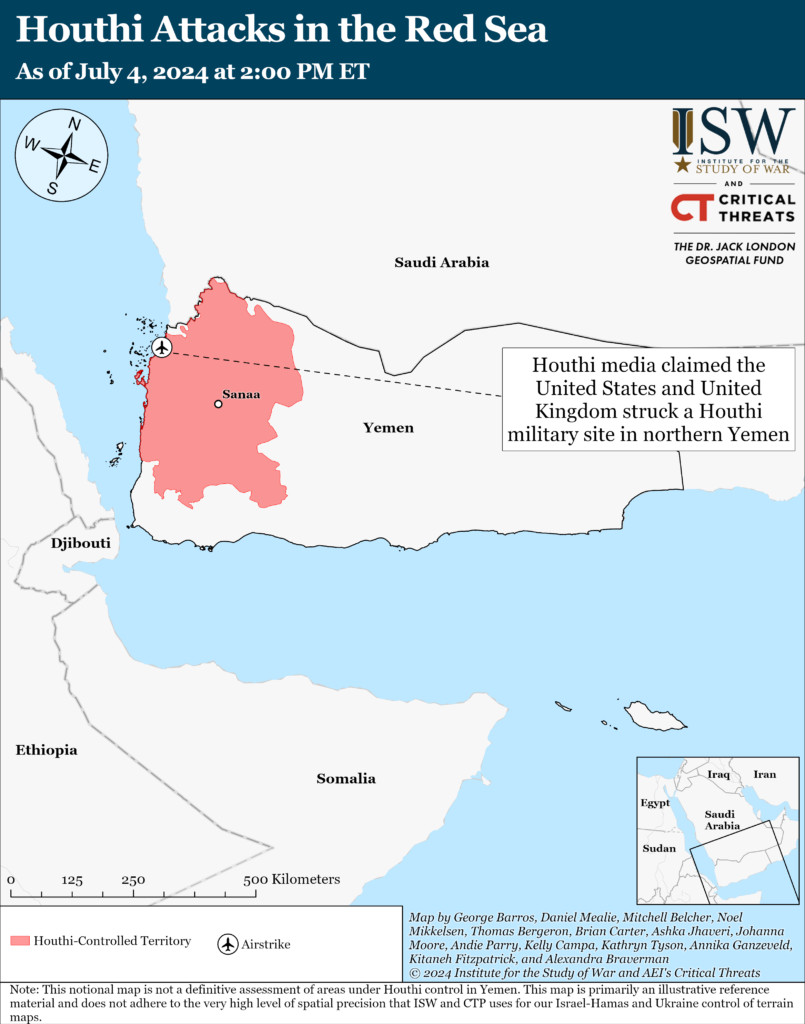
 Eurasia Press & News
Eurasia Press & News
